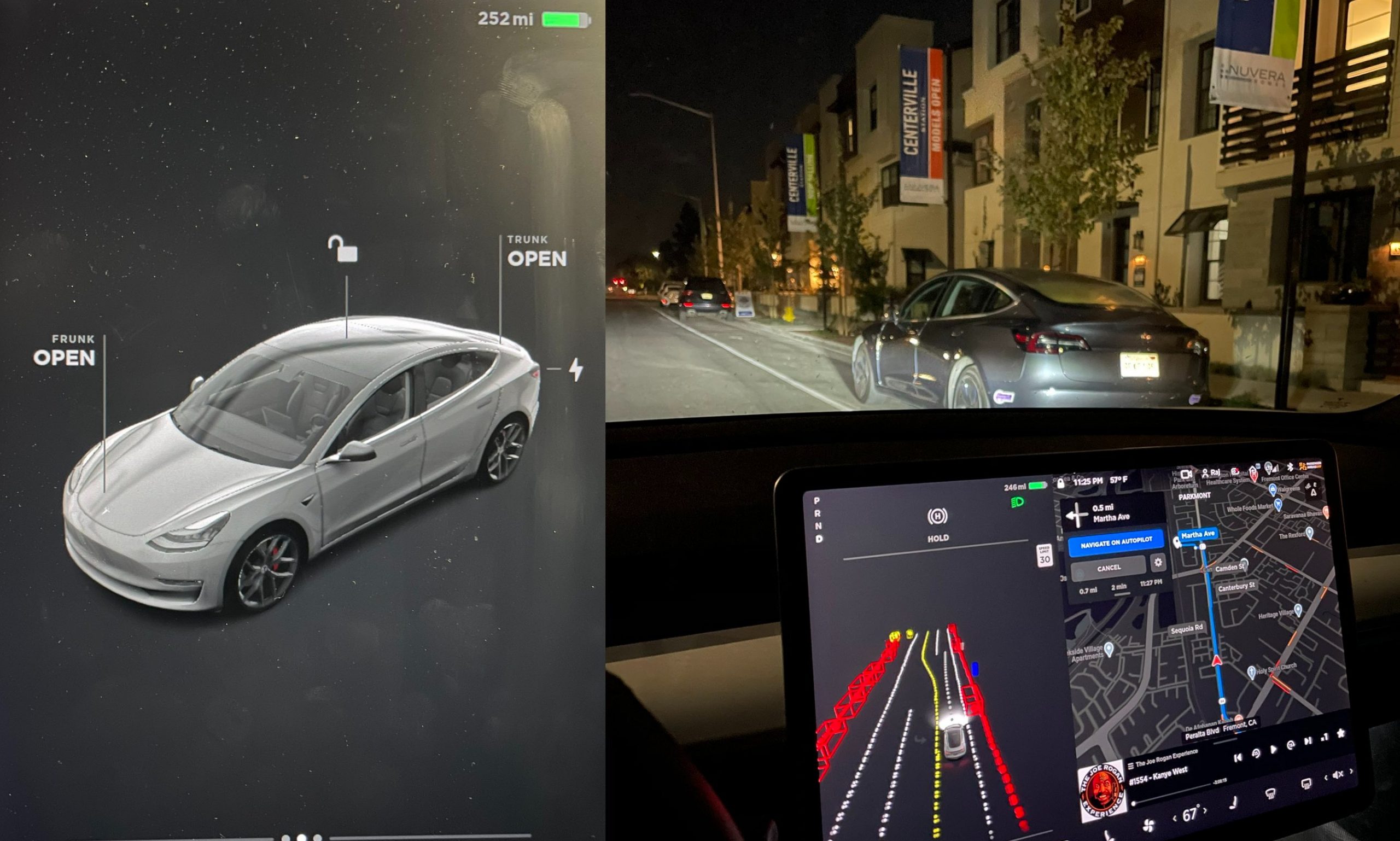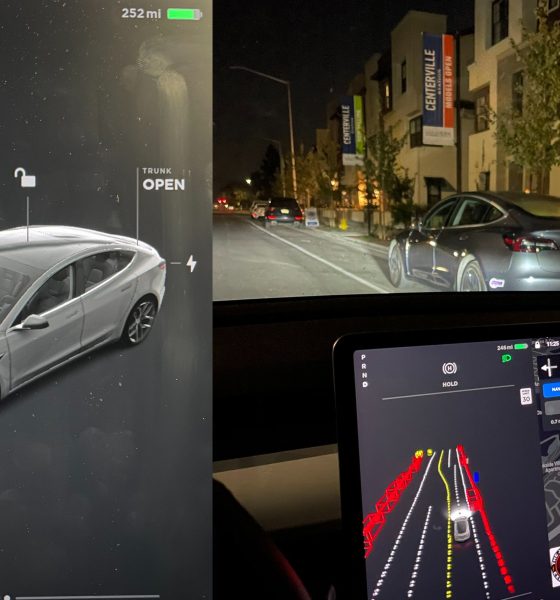

News
First look at Tesla’s new UI and driving visualizations for FSD beta in action
Tesla has started rolling out software version 2020.40.8.12 to users of the company’s limited Full Self-Driving beta, and based on observations from the EV community, it appears that the update includes a new UI that is optimized for the operation of the FSD suite. This is evident in the UI’s larger space for FSD’s driving visualizations, as well as its smoother, vector renders for driving paths, objects, and streets.
Images of Tesla’s new UI were shared by limited FSD beta user Tesla Raj, who seemed to be among the first Model 3 owners who received the update. As noted by the Tesla enthusiast, immediately noticeable was the larger space allotted for visualizations. This is especially striking when the vehicle is in Park, as the Tesla avatar on the display has now gotten considerably larger and more detailed. The animation when opening the trunk, frunk, and doors is now smoother as well.
The changes in Tesla’s UI does affect the layout of the center display. With a larger space allotted for driving visualizations, the area for the map has been reduced. The Tesla “T” logo at the top of the display has also been removed. Whether this would be popular among Tesla owners is up for question, though it is evident that the change was made with regards to the growing functionalities of the Full Self-Driving suite. Tesla explained this in its Release Notes for 2020.40.8.12.
Driving Visualization Improvements
The driving visualization has been improved to better support Full Self-Driving capabilities by increasing the display size to show additional surrounding information. The next turn will now appear above the visualization if the navigation turn list is covered by another app.
With the larger visualization, select items have slightly moved but will continue to look and behave the same. Some notable differences include the following:
- Quick access to the backup camera and wipers has moved to the bottom bar.
- Autopilot set speed is now displayed directly below the speedometer and can continue to be adjusted using the right steering wheel scroll wheel. The speed will turn blue when Autopilot is engaged.
What is rather interesting is the fact that the improvements being introduced to the Full Self-Driving beta have been coming at an incredibly rapid pace. Since rolling out to members of the limited FSD beta just over a week ago, the system’s capabilities have already started exhibiting more refinements. This was observed by the Tesla Owners Silicon Valley group, who asked how the new update and UI could enhance FSD’s actual performance on the road. In a response, Musk stated that the update may result in fewer interventions.
“We measure this primarily in intervention probability. This update addressed several issues, resulting in perhaps ~1/3 fewer interventions. Many of the improvements consist of fixing silly bugs vs grand eureka moments. True for most beta releases in my experience,” Musk wrote.
Elaborating further, Musk explained that as Full Self-Driving improves, the faults that will be experienced by the system will likely decrease significantly. The CEO explained that while FSD’s faults would never be zero, there will eventually be a point when its probability of faults will be notably lower than that of an average human driver. Musk added that the updates to the limited FSD beta would be quite rapid as well, with new improvements being rolled out every 5 to 10 days.
Watch a first look at Tesla’s new UI and driving visualizations in the video below.

News
Elon Musk’s Grok AI to be used in U.S. War Department’s bespoke AI platform
The partnership aims to provide advanced capabilities to 3 million military and civilian personnel.

The U.S. Department of War announced Monday an agreement with Elon Musk’s xAI to embed the company’s frontier artificial intelligence systems, powered by the Grok family of models, into the department’s bespoke AI platform GenAI.mil.
The partnership aims to provide advanced capabilities to 3 million military and civilian personnel, with initial deployment targeted for early 2026 at Impact Level 5 (IL5) for secure handling of Controlled Unclassified Information.
xAI Integration
As noted by the War Department’s press release, GenAI.mil, its bespoke AI platform, will gain xAI for the Government’s suite of tools, which enable real-time global insights from the X platform for “decisive information advantage.” The rollout builds on xAI’s July launch of products for U.S. government customers, including federal, state, local, and national security use cases.
“Targeted for initial deployment in early 2026, this integration will allow all military and civilian personnel to use xAI’s capabilities at Impact Level 5 (IL5), enabling the secure handling of Controlled Unclassified Information (CUI) in daily workflows. Users will also gain access to real‑time global insights from the X platform, providing War Department personnel with a decisive information advantage,” the Department of War wrote in a press release.
Strategic advantages
The deal marks another step in the Department of War’s efforts to use cutting-edge AI in its operations. xAI, for its part, highlighted that its tools can support administrative tasks at the federal, state and local levels, as well as “critical mission use cases” at the front line of military operations.
“The War Department will continue scaling an AI ecosystem built for speed, security, and decision superiority. Newly IL5-certified capabilities will empower every aspect of the Department’s workforce, turning AI into a daily operational asset. This announcement marks another milestone in America’s AI revolution, and the War Department is driving that momentum forward,” the War Department noted.
News
Tesla FSD (Supervised) v14.2.2 starts rolling out
The update focuses on smoother real-world performance, better obstacle awareness, and precise end-of-trip routing, among other improvements.

Tesla has started rolling out Full Self-Driving (Supervised) v14.2.2, bringing further refinements to its most advanced driver-assist system. The new FSD update focuses on smoother real-world performance, better obstacle awareness, and precise end-of-trip routing, among other improvements.
Key FSD v14.2.2 improvements
As noted by Not a Tesla App, FSD v14.2.2 upgrades the vision encoder neural network with higher resolution features, enhancing detection of emergency vehicles, road obstacles, and human gestures. New Arrival Options let users select preferred drop-off styles, such as Parking Lot, Street, Driveway, Parking Garage, or Curbside, with the navigation pin automatically adjusting to the user’s ideal spot for precision.
Other additions include pulling over for emergency vehicles, real-time vision-based detours for blocked roads, improved gate and debris handling, and extreme Speed Profiles for customized driving styles. Reliability gains cover fault recovery, residue alerts on the windshield, and automatic narrow-field camera washing for new 2026 Model Y units.
FSD v14.2.2 also boosts unprotected turns, lane changes, cut-ins, and school bus scenarios, among other things. Tesla also noted that users’ FSD statistics will be saved under Controls > Autopilot, which should help drivers easily view how much they are using FSD in their daily drives.
Key FSD v14.2.2 release notes
Full Self-Driving (Supervised) v14.2.2 includes:
- Upgraded the neural network vision encoder, leveraging higher resolution features to further improve scenarios like handling emergency vehicles, obstacles on the road, and human gestures.
- Added Arrival Options for you to select where FSD should park: in a Parking Lot, on the Street, in a Driveway, in a Parking Garage, or at the Curbside.
- Added handling to pull over or yield for emergency vehicles (e.g. police cars, fire trucks, ambulances).
- Added navigation and routing into the vision-based neural network for real-time handling of blocked roads and detours.
- Added additional Speed Profile to further customize driving style preference.
- Improved handling for static and dynamic gates.
- Improved offsetting for road debris (e.g. tires, tree branches, boxes).
- Improve handling of several scenarios, including unprotected turns, lane changes, vehicle cut-ins, and school buses.
- Improved FSD’s ability to manage system faults and recover smoothly from degraded operation for enhanced reliability.
- Added alerting for residue build-up on interior windshield that may impact front camera visibility. If affected, visit Service for cleaning!
- Added automatic narrow field washing to provide rapid and efficient front camera self-cleaning, and optimize aerodynamics wash at higher vehicle speed.
- Camera visibility can lead to increased attention monitoring sensitivity.
Upcoming Improvements:
- Overall smoothness and sentience.
- Parking spot selection and parking quality.
News
Tesla is not sparing any expense in ensuring the Cybercab is safe
Images shared by the longtime watcher showed 16 Cybercab prototypes parked near Giga Texas’ dedicated crash test facility.

The Tesla Cybercab could very well be the safest taxi on the road when it is released and deployed for public use. This was, at least, hinted at by the intensive safety tests that Tesla seems to be putting the autonomous two-seater through at its Giga Texas crash test facility.
Intensive crash tests
As per recent images from longtime Giga Texas watcher and drone operator Joe Tegtmeyer, Tesla seems to be very busy crash testing Cybercab units. Images shared by the longtime watcher showed 16 Cybercab prototypes parked near Giga Texas’ dedicated crash test facility just before the holidays.
Tegtmeyer’s aerial photos showed the prototypes clustered outside the factory’s testing building. Some uncovered Cybercabs showed notable damage and one even had its airbags engaged. With Cybercab production expected to start in about 130 days, it appears that Tesla is very busy ensuring that its autonomous two-seater ends up becoming the safest taxi on public roads.
Prioritizing safety
With no human driver controls, the Cybercab demands exceptional active and passive safety systems to protect occupants in any scenario. Considering Tesla’s reputation, it is then understandable that the company seems to be sparing no expense in ensuring that the Cybercab is as safe as possible.
Tesla’s focus on safety was recently highlighted when the Cybertruck achieved a Top Safety Pick+ rating from the Insurance Institute for Highway Safety (IIHS). This was a notable victory for the Cybertruck as critics have long claimed that the vehicle will be one of, if not the, most unsafe truck on the road due to its appearance. The vehicle’s Top Safety Pick+ rating, if any, simply proved that Tesla never neglects to make its cars as safe as possible, and that definitely includes the Cybercab.








